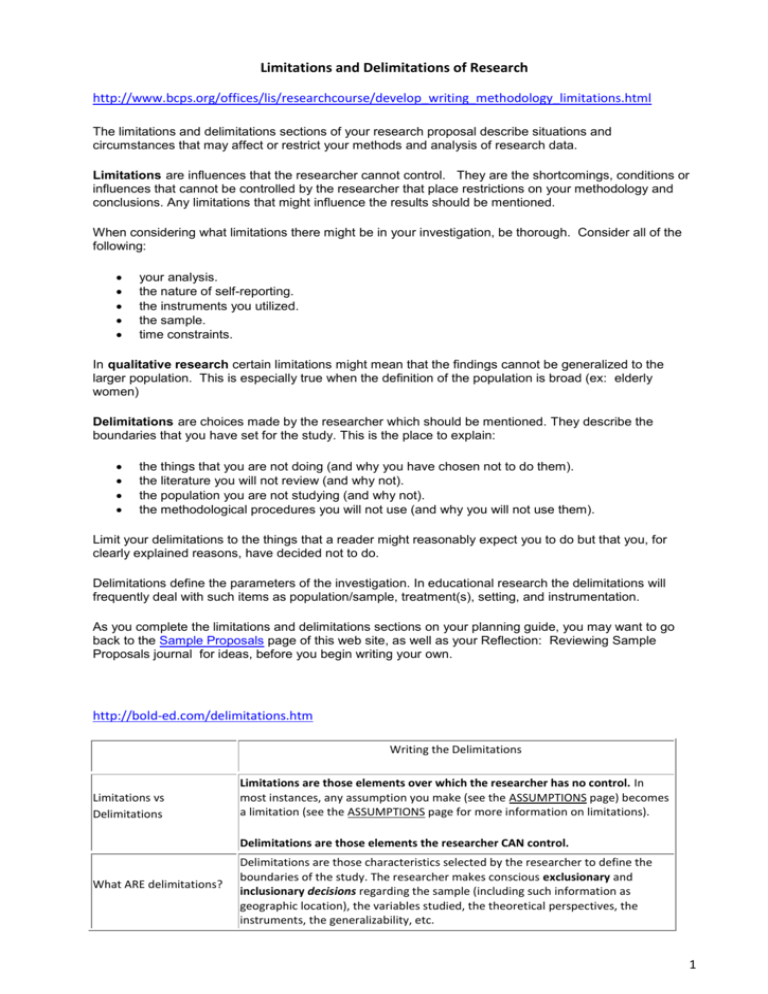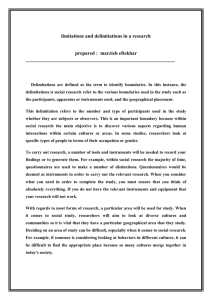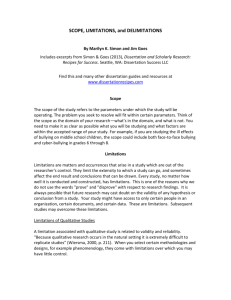Limitations and Delimitations of Research
advertisement

Limitations and Delimitations of Research http://www.bcps.org/offices/lis/researchcourse/develop_writing_methodology_limitations.html The limitations and delimitations sections of your research proposal describe situations and circumstances that may affect or restrict your methods and analysis of research data. Limitations are influences that the researcher cannot control. They are the shortcomings, conditions or influences that cannot be controlled by the researcher that place restrictions on your methodology and conclusions. Any limitations that might influence the results should be mentioned. When considering what limitations there might be in your investigation, be thorough. Consider all of the following: your analysis. the nature of self-reporting. the instruments you utilized. the sample. time constraints. In qualitative research certain limitations might mean that the findings cannot be generalized to the larger population. This is especially true when the definition of the population is broad (ex: elderly women) Delimitations are choices made by the researcher which should be mentioned. They describe the boundaries that you have set for the study. This is the place to explain: the things that you are not doing (and why you have chosen not to do them). the literature you will not review (and why not). the population you are not studying (and why not). the methodological procedures you will not use (and why you will not use them). Limit your delimitations to the things that a reader might reasonably expect you to do but that you, for clearly explained reasons, have decided not to do. Delimitations define the parameters of the investigation. In educational research the delimitations will frequently deal with such items as population/sample, treatment(s), setting, and instrumentation. As you complete the limitations and delimitations sections on your planning guide, you may want to go back to the Sample Proposals page of this web site, as well as your Reflection: Reviewing Sample Proposals journal for ideas, before you begin writing your own. http://bold-ed.com/delimitations.htm Writing the Delimitations Limitations vs Delimitations Limitations are those elements over which the researcher has no control. In most instances, any assumption you make (see the ASSUMPTIONS page) becomes a limitation (see the ASSUMPTIONS page for more information on limitations). Delimitations are those elements the researcher CAN control. What ARE delimitations? Delimitations are those characteristics selected by the researcher to define the boundaries of the study. The researcher makes conscious exclusionary and inclusionary decisions regarding the sample (including such information as geographic location), the variables studied, the theoretical perspectives, the instruments, the generalizability, etc. 1 This study is delimited to (list all qualifications a participant/subject must meet in Inclusionary delimitations order to be included in the study). For example, Participation in this study is delimited to teachers who (a) teach third grade in a private school, (b) in the state (participants) of California, and (c) have taught more than five years. Exclusionary delimitations Teachers who meet all other qualifications but have previously taught in a public (participants) school environment will be excluded from the study. Inclusionary delimitations The study will be delimited to examination of teachers' self-efficacy when teaching mathematics. (variables) Exclusionary delimitations Teachers' self-efficacy in other subject areas will not be considered. (variables) Inclusionary delimitations Self-efficacy will be measured on a Likert-type scale with an instrument designed (instrumentation) specifically for the proposed study. Only those questions that are approved by an expert panel will be included in the Exclusionary delimitations survey instrument. Further, test-retest reliability analysis will be used to determine which questions on the self-efficacy instrument will be utilized in the (instrumentation) final document. Inclusionary delimitations The results of the proposed study will be generalizable to teachers who (a) teach third grade in a private school, (b) in the state of California, and (c) have taught (generalizability) more than five years. Exclusionary delimitations The results of the proposed study will not be generalizable to teachers who have (generalizability) previously taught in a public school environment. http://bold-ed.com/assumptions.htm Writing the Assumptions and Limitations What ARE the Assumptions? Assumptions are those things we take for granted in the study: statements by the researcher that certain elements of the research are understood to be true. While assumed, they should still be explicitly stated in the body of the dissertation, usually in chapter 1. Types of Assumptions Assumptions are made about (a) the theory under investigation, (b) the phenomenon under investigation, (c) the instrument, (d) the methodology, (e) the analysis, (f) the power to find significance, (g) the participants in the study, and (h) the results. What ARE limitations? Limitations are those elements over which the researcher has no control. In most instances, any assumption you make becomes a limitation. Delimitations are those elements the researcher CAN control (see the delimitations page for more information) . Assumption: Theoretical Foundation After writing the theoretical foundation of your study, you, the researcher, are making the assumption that the foundation of your study is sound. The theoretical framework is assumed to be an accurate reflection of the phenomena 2 being studied. Therefore, the results of your study are limited by the accuracy of the theoretical framework to reflect the phenomena under study. Limitation: Theoretical Foundation Assumption: The Phenomenon Consider the variables self-esteem (belief in yourself) and self-efficacy (belief in your abilities). If the theoretical foundation of your study was based on one of these variables, and the variable you actually measured was the other, then the theoretical foundation of your study may be flawed. This limits the accuracy of your results. So a study is limited by whether the theoretical foundation of your study is an accurate reflection of the phenomena/variables you are studying. Before beginning your study, the phenomenon under investigation must be clearly defined, and it must be measurable. It is assumed the variables have been clearly defined and are measurable. Limitation: The Phenomenon Many theoretical constructs measured in the social sciences are difficult to define. Review studies on concepts such as job satisfaction or student success, and you will find different definitions and different measurement instruments. Your study is limited by your definition (how broadly or narrowly you define the phenomenon under investigation). For example, one might measure student success by test scores, graduation rates, or employment after completion. The results of your study will vary widely, depending on which of these definitions you select! Assumption: The Instrument The researcher assumes that the variables under investigation are measurable (sounds easy: gender, age, etc., but how do you measure happiness?), and the instrument being used is a valid and reliable instrument to measure those variables. Limitation: The Instrument Instruments are limited by their reliability and validity. An instrument is reliable if it will give the same measurement every time when measuring the same construct. Consider weight - if you weigh yourself at home, then weigh yourself 5 minutes later, you should get the same measurement unless YOU have changed (put on/removed clothes). That's reliability. If you weigh yourself at home, you may get a different measurement than at the doctor's office or the gym. Which scale is valid? If the density of the ground below each area is different, they ALL may be valid. If the density is the same, you need to determine WHICH scale is giving you the correct weight - only ONE is valid. Assumption: The Methodology The researcher assumes the methodology is appropriate to the problem being addressed and the purpose of the study. For example, quantitative analysis is rarely appropriate to address how or why questions. Limitation: The Methodology The results of the study are limited by the ability of the methodology to address the problem and purpose. You might address the same research questions by several different methodologies. WHICH methodology you choose may increase or decrease your ability to find the answer you are seeking. 3 Assumption: The Analysis Every statistical procedure has certain requirements. For example, most parametric analyses (e.g., Pearson correlations, ANOVAS) require normally distributed data. Therefore, you, as the researcher, assume that the data will be normally distributed. If the data are NOT normally distributed, then you might consider using a nonparametric procedure such as Spearman Rho instead of the Pearson correlation coefficient. Limitation: The Analysis The results of your study are limited by the ability of the statistical procedure selected to find statistical significance. The analysis must be appropriate to address the research question, and the test must have sufficient power to detect significance differences/relationships if they exist in the population. Assumption: The Power to Detect Before conducting the analysis, the researcher assumes that the analysis selected and the size of the sample are sufficient to detect significant differences/relationships if they exist in the population. Limitation: The Power to Detect The results of your study are limited by the ability of the statistical test to detect significant differences/relationships if they exist in the population (note: you will likely *not* find differences in your sample if they DO NOT EXIST in the population!). G*Power is a free software program designed to determine the power of statistical tests. Assumption: The Participants In order for a study to be valid, the participants must be representative of the population, must be willing to participate in the study, and must respond to questions honestly or participate without biasing the study results (i.e., not behaving differently than they would were they not participating in a research study). Limitation: The Participants Your study is limited by how well the participants in the study represent the population (this is why sample selection is so important! Nonrandom sampling means your participants likely do not represent the population). In addition, the results of your study are limited by the honesty of your participants, or their nonbiased participation (i.e., not changing their behavior because they know they are participating in a study). Assumption: The Results Once your analysis is complete, you assume that the results are generalizable beyond the sample being studied. Finally, it is assumed that the results of the study will be relevant to stakeholders. This is the most compelling assumption: that the results will be meaningful. Limitation: The Results The generalizability is limited by how well the sample represents the population. The study is also limited by the usefulness of the results to important stakeholders. http://phdstudent.com/Choosing-a-Research-Design/stating-the-obvious-writing-assumptionslimitations-and-delimitations When you finish your research and contemplate Chapter 1 of your thesis or dissertation, you might suddenly realize that your research has inherent flaws. Don’t worry! Virtually all research projects contain limitations. 4 However, being able to recognize these problems is the difference between a true researcher and a grade-school kid with a science-fair project. Availability of resources and dealing with human emotions are just a couple of examples of assumptions, delimitations, and limitations of a dissertation. In the following sections, the differences among assumptions, delimitations, and limitations of a dissertation will be clarified. Assumptions Assumptions are factors in your research that are out of your control to a certain degree but that are integral to your study; quite plainly, assumptions are things that are assumed by researchers and peers who will read your paper. The most common explanation of an assumption is stating why the anonymity and confidentiality of participants will be preserved and how the researcher will do this. For example, imagine a dissertation or thesis in which the researcher studies the effects of mothers’ eating habits on fetuses. An assumption could be justified by showing that all participating mothers have access to and money for the same grocery stores in the area. The researcher could provide statistics for how participating mothers meet the qualifications for the whole group being studied; thereby making participating mothers representatives of the whole population. Limitations Limitations of a dissertation are potential weaknesses in your study that are out of your control. Do not worry about limitations because limitations affect most things in life. Even when you are going to your favorite restaurant, you are limited by the menu choices. If you went to a restaurant that had a menu that you were craving, you might not receive the service, price, or location that makes you enjoy your favorite restaurant. If you studied participants’ responses to a survey, you were limited in your abilities to gain these participants. The people whom you managed to get to take your survey are not truly a random sample, which is also a limitation. If you used a common test for data findings, your results are limited by the reliability of the test. If your study was limited to a certain amount of time, your results are affected by the operations of society during that time period (e.g., economy, social trends). It is important for you to remember that limitations of a dissertation are often not something that can be solved by the researcher. Also, remember that whatever limits you also limits other researchers, whether they are the largest medical research companies or consumer habits corporations. Limitations of a dissertation are typically reported in the discussion section of your paper. Delimitations Delimitations are the definitions you set as the boundaries of your own thesis or dissertation, so delimitations are in your control. Delimitations are set so that your goals do not become impossibly large to complete. Examples of delimitations include objectives, research questions, variables, theoretical objectives that you have adopted, and populations chosen as targets to study. When you are stating your delimitations, clearly inform readers why you chose this course of study. The answer might simply be that you were curious about the topic and/or wanted to improve standards of a professional field by revealing certain findings. In any case, you should clearly list the other options available and the reasons why you did not choose these options immediately after you list your 5 delimitations. You might have avoided these options for reasons of practicality, interest, or relativity to the study at hand. For example, you might have only studied Hispanic mothers because they have the highest rate of obese babies. Don’t forget to describe the philosophical framework you used throughout your study, which also delimits your study. 6









